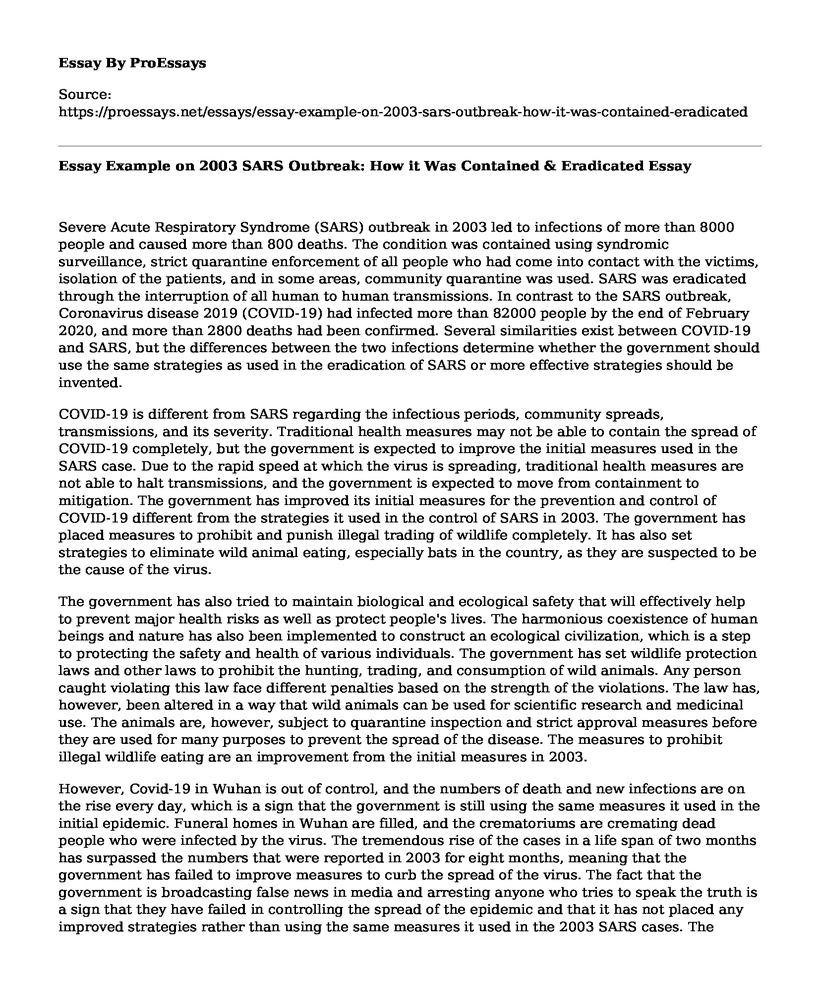Severe Acute Respiratory Syndrome (SARS) outbreak in 2003 led to infections of more than 8000 people and caused more than 800 deaths. The condition was contained using syndromic surveillance, strict quarantine enforcement of all people who had come into contact with the victims, isolation of the patients, and in some areas, community quarantine was used. SARS was eradicated through the interruption of all human to human transmissions. In contrast to the SARS outbreak, Coronavirus disease 2019 (COVID-19) had infected more than 82000 people by the end of February 2020, and more than 2800 deaths had been confirmed. Several similarities exist between COVID-19 and SARS, but the differences between the two infections determine whether the government should use the same strategies as used in the eradication of SARS or more effective strategies should be invented.
COVID-19 is different from SARS regarding the infectious periods, community spreads, transmissions, and its severity. Traditional health measures may not be able to contain the spread of COVID-19 completely, but the government is expected to improve the initial measures used in the SARS case. Due to the rapid speed at which the virus is spreading, traditional health measures are not able to halt transmissions, and the government is expected to move from containment to mitigation. The government has improved its initial measures for the prevention and control of COVID-19 different from the strategies it used in the control of SARS in 2003. The government has placed measures to prohibit and punish illegal trading of wildlife completely. It has also set strategies to eliminate wild animal eating, especially bats in the country, as they are suspected to be the cause of the virus.
The government has also tried to maintain biological and ecological safety that will effectively help to prevent major health risks as well as protect people's lives. The harmonious coexistence of human beings and nature has also been implemented to construct an ecological civilization, which is a step to protecting the safety and health of various individuals. The government has set wildlife protection laws and other laws to prohibit the hunting, trading, and consumption of wild animals. Any person caught violating this law face different penalties based on the strength of the violations. The law has, however, been altered in a way that wild animals can be used for scientific research and medicinal use. The animals are, however, subject to quarantine inspection and strict approval measures before they are used for many purposes to prevent the spread of the disease. The measures to prohibit illegal wildlife eating are an improvement from the initial measures in 2003.
However, Covid-19 in Wuhan is out of control, and the numbers of death and new infections are on the rise every day, which is a sign that the government is still using the same measures it used in the initial epidemic. Funeral homes in Wuhan are filled, and the crematoriums are cremating dead people who were infected by the virus. The tremendous rise of the cases in a life span of two months has surpassed the numbers that were reported in 2003 for eight months, meaning that the government has failed to improve measures to curb the spread of the virus. The fact that the government is broadcasting false news in media and arresting anyone who tries to speak the truth is a sign that they have failed in controlling the spread of the epidemic and that it has not placed any improved strategies rather than using the same measures it used in the 2003 SARS cases. The government has placed travel bans to any country outside China, with airports remaining empty to curb travels that would make containment of the disease harder. Major economic losses are being realized to both the airline industries and the economies as it happened in 2003. In 2003, no travel bans were implemented, but travel advisories were used to stop people from having non-essential travels to countries that were affected by SARS.
Most of the strategies that were used in the containment of the 2003 SARS are the same strategies that are being used in the COVID-19 containment despite it being more deadly than the epidemic in 2003. Social distancing in public areas and quarantine has been the most adopted strategy in both of the years, and though they worked in the past, they do not seem to be working very well in the current epidemic. The virus is spreading very fast across cities and nations worldwide, and governments have been forced to close down schools to reduce any chances of the students getting contaminated and easily spreading the disease amongst themselves. All public places have been closed down, and public holidays canceled to reduce the chances of people contracting the disease. These same strategies were used in the 2003 SARS, and the government does not seem to be improving the strategies it is using in the fight against coronavirus.
References
Chen, Z., Zhang, W., Lu, Y., Guo, C., Guo, Z., Liao, C., & Lipkin, W. I. (2020). From SARS-CoV to Wuhan 2019-nCoV: Will History Repeat Itself?. bioRxiv. https://www.biorxiv.org/content/biorxiv/early/2020/01/27/2020.01.24.919241.full.pdf
Wilder-Smith, A., Chiew, C. J., & Lee, V. J. (2020). Can we contain the COVID-19 outbreak with the same measures as for SARS?. The Lancet Infectious Diseases. https://www.thelancet.com/action/showPdf?pii=S1473-3099%2820%2930129-8
Cite this page
Essay Example on 2003 SARS Outbreak: How it Was Contained & Eradicated. (2023, May 21). Retrieved from https://proessays.net/essays/essay-example-on-2003-sars-outbreak-how-it-was-contained-eradicated
If you are the original author of this essay and no longer wish to have it published on the ProEssays website, please click below to request its removal:
- Comorbidity of Fibromyalgia and Mental Illness - Research Paper
- Patricia Benner's Nursing Theory Essay
- Essay Sample on Incivility in the Workplace
- Equipoise in Research - Essay Sample
- Essay Example on Aristotle: Living Well Is Purposeful, Intentional Behavior
- Paper Example on Free Will vs Determinism: The Philosophical Debate
- Abortion - Free Essay Example







